Julie and I are fully immersed in a water-oriented, nomadic lifestyle; we’ve been cruising together for nearly 30 years. While most of that experience has been on wind-driven keel boats, we’ve paddled canoes and kayaks, partied on pontoon boats and raced across water in motorboats. We’re open to nearly any water-related experience.
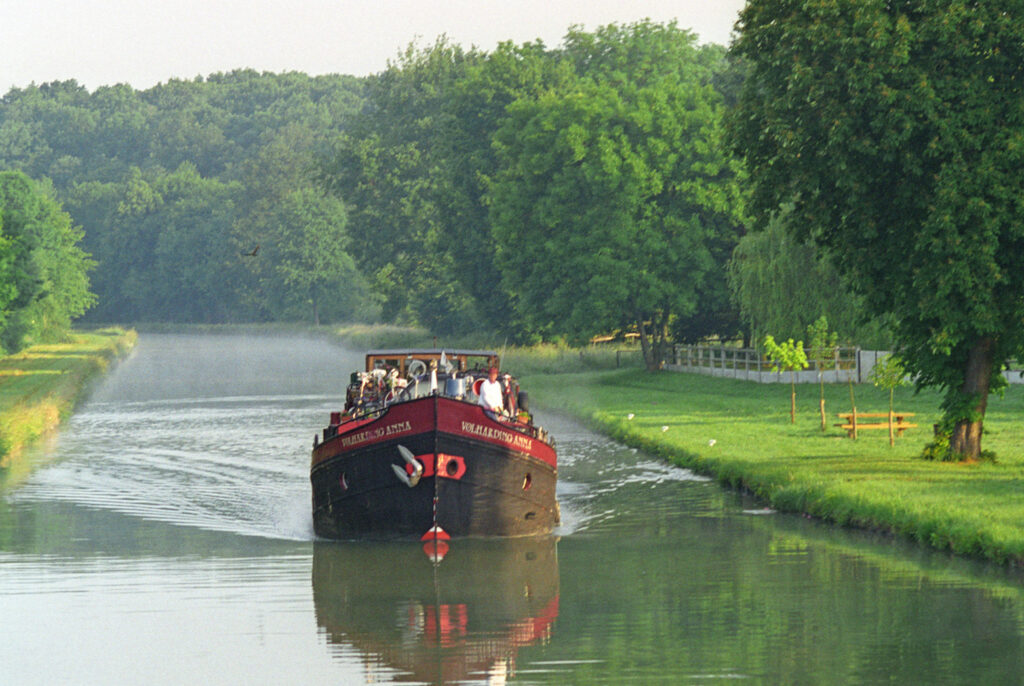
In 1998 Julie and I met up with our friends Gene and Kathleen in Fontainebleau, France—southeast of Paris— for a barge cruise on the Briare Canal. Julie and Gene were former co-workers. When his family moved to Minnesota, they bought a house a couple miles from our Chanhassen home. We socialized with them on a regular basis. After discovering a mutual interest in cruising on a canal in France, Kathleen found a 110-foot coal barge that had been converted to a crewed charter boat. It was owned and captained by a retired American couple on their maiden cruise in France. We had a blast and agreed to do it again.
The Present
Fast forward 24 years. Gene and Kathleen had long since relocated to Seattle. We got together with them separately and jointly a few times, including a bareboat sailing charter in the British Virgin Islands. Our recent house sits on the Puget Sound allowed us to reconnect more frequently. Last year we visited them at their waterfront cabin an hour from our recurring house sit on the Hood Canal. We were due for a good reunion.
When Julie secured a pair of house sits in France last fall—our first in Europe–a vacation opportunity opened. The two sits were separated by a week. The first sit was near Limoges. The second house sit was in the south of France— which Julie talks about in a recent Gaviidae Sails posting. Significantly, this house sit was near the Canal du Midi, numero uno on our French canal bucket list for a couple of reasons:
- First, access to history. The section of the canal we chose to cruise is in Languedoc, a region with a long, colorful history that is still evident in the ancient walled villages and cities along the canal’s banks and immediate area.
- Second, the wine. Languedoc-Roussillon stretches from Provence to Spain. With some 700,000 acres planted in grape vines, it the largest wine-producing region in the world. Over a third of all the grapes used to make wine in France come from the region.
After booking our flights to and from Paris and researching cruising options on the Canal du Midi, Julie called Kathleen proposing a canal trip. She immediately said, “Yes,” then realized it would be prudent to consult Gene. Gene was all in and 24 hours later we were booked on a peniche (boat) in France and our friends began making their travel plans.
Midi History
The Canal du Midi is probably the most famous and popular of the many canals in France that accommodate leisure boat charters. It winds through pastoral fields and vineyards and past ancient walled villages in the old Languedoc region, now known as l’Occitanie (Occitania), in southwest France. The canal was constructed in the late 1600s as a waterway shortcut between the Atlantic Ocean and the Mediterranean Sea. It provided a faster, safer and less expensive way to transport people, foodstuff and wine to and from the south of France to northern France without going around Spain and the Iberian Peninsula.
The Canal du Midi and its manmade water source—a dam near the canal’s highest elevation– was the biggest and most complicated engineering achievement in Europe since the glory days of the Roman Empire. Connected to navigable rivers at both ends, the Midi incorporates 63 locks (écluses in French) to raise and lower watercraft to and from its highest elevation of just over 620 feet above sea level. It stretches 150 miles from the Garonne River near Toulouse in Bordeaux south to the Aude River, which empties into the Mediterranean near Narbonne. A branch of the Midi reaches east of the Aude to the Orb River, past Béziers and on to the Mediterranean port village of Agde.
Building the Canal
To make the Midi functional, ingenious water storage and delivery systems were designed and built. New construction included tunnels, bridges and the first aqueduct over a river in France. The project required some 12,000 men working 14 years to complete. The self-taught engineer behind the project, Pierre-Paul Riquet, was a tax collector from Béziers (pronounced bezj yay’.) He created a marvel of its age that continues to inspire awe nearly 350 years after it opened for business in 1681. In 1996, UNESCO designated the Canal du Midi a World Heritage Site, lauding its “technological innovation with aesthetic, architectural and landscape design that has few parallels.”
The canal’s commercial importance peaked in the 1860s. By the 1980s, leisure boating had replaced all commercial uses. Today, the canal accommodates some 10,000 boats ranging from small skiffs to so-called “hire boats” to floating hotels. An estimated 100,000 boaters use the canal annually. Visitors flock to the area from around the world not only for the boating, but to bike and hike along the old tow paths, explore the ancient villages and towns along and near the canal, and tour the vineyards and world-class wineries in the region.
We elected to charter a hire boat on the Canal du Midi for all the reasons mentioned. While we knew a week would only give us a taste of what the Midi has to offer, we knew we’d squeeze plenty of adventure and culture and fermented grape juice out of our time there.
Prep and Cruise
Our Canal du Midi trip began at the end of the canal’s cruising season. The timing meant off-season charter costs, less traffic on the water and it fit nicely between our house sits in France. Starting near Agde on the Mediterranean, our destination, Homps, would be a weeklong cruise and just a few kilometers from our next house sit. The homeowner could meet us at the boat.
In mid-October, Julie and I drove four hours from our northern France housesit to the Le Boat charter boat base in Port Cassafières—near Agde. We had rented a car to get us to our initial house sit and for our stay there, then drove it to Port Cassafières. Gene and Kathleen were waiting for us at the charter office when we arrived. They had been in the area a couple days and hadn’t had to travel far. After greetings were made, documents signed and monies paid we took our gear to the assigned boat. We were on a newer 37-foot Horizon 2 canal boat with two cabins and ensuite bathrooms with showers. For some reason, Le Boat hire boats are unnamed. It didn’t occur to me to ask why until I started writing this post.
Boat Briefing
Once our gear was stowed, a Le Boat employee came aboard to brief us about the boat’s features and explain handling instructions, safety and canal protocols. I had drawn the short straw and was designated captain for this excursion, so I also got a quick hands-on lesson in starting, driving and backing the boat into its very narrow slip. Between the Le Boat crewman’s limited English and my rusty French we got things sorted out quickly. It was all made easier by the fact that our little crew are all experienced sailors with boat handling, navigation and even lock skills: This wasn’t our first canal trip. In addition, we had all already viewed the charter company’s online video, which was mandatory viewing for everyone aboard. We were deemed ready to cruise after an hour-long briefing.
Provisioning
After the Le Boat instructor departed, the four of us drove to a store to sort out provisioning for the next few days and return the rental car. At the small neighborhood store we found, we bought cheeses, assorted sausages and meats, vegetables, a baguette and some sandwich bread and lots of wine and other adult beverages. We anticipated provisioning along the way and dining ashore frequently—whether for lunch or dinner. Leftovers were expected to fill in gaps, as were expected winery tours.
The sun was setting in the west by the time we returned from our errands. Since rental boats must be moored from sunset to dawn, we opted to stay put in the Le Boat base. Nobody wanted to cook so we had pizza and salad delivered for dinner en peniche. Ordering in allowed us to focus on socializing and discussing the upcoming week on the canal.
Mooring
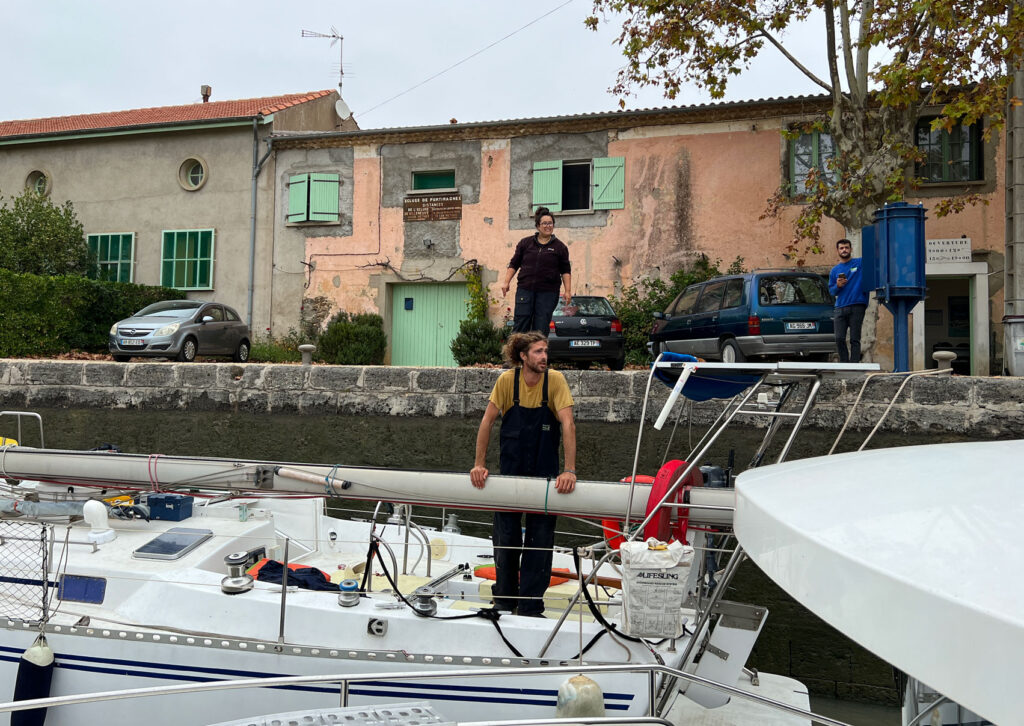
Mooring options on the Midi include finding a slip in a harbor or marina in one of the towns along the canal, tying the boat to bollards scattered intermittently along the banks of the canal, or driving stakes into the bank and securing the boat away from any villages or chateaux. Stakes and dock lines were already on board, so mooring is a simple proposition. Negotiating locks would be the most complicated thing we would do with the boat.
We stayed at the Port Cassafières base that first night, which was a Monday, and headed up the canal the next morning. Our first canal lock was just a few kilometers away at Portiragnes. We navigated that lock without incident and passed through two more. We shared the locks with a 37-foot sailboat driven by a young French couple. Its mast was lashed to the deck so it could enter locks and pass under bridges–much as Julie and I did on the Erie Canal in 2017. The sailboat crew were new owners heading to Brittany on the Atlantic Ocean. It was interesting to observe firsthand that the canal is still used in the way it was originally intended.
Locking Up
The Midi locks proved to be easier to maneuver through than locks we encountered on the Erie Canal in New York state, the Welland Canal between Lake Erie and Lake Ontario, and the Canadian lock at Sault Ste. Marie between Lake Superior and Lake Huron. The French locks were typically smaller with shorter elevations.
We devised a simple strategy to negotiate these locks. Before entering a lock, we pulled up along shore so Gene and Kathleen could jump ship and go ahead to the lock while we awaited permission from an éclusier (“eh clew zhiay”–lock keeper). They would position themselves on whichever side of the lock the éclusier wanted us for the ride up as water filled the lock.
We usually shared the lock with one or more other boats. Since we were motoring upstream, we always “locked up” to the next level; Kathleen and/or Julie would toss the free ends of our dock lines up to Gene who wrapped them around cleats or bollards so he could pull the dock line as the boat floated up on the rising water. Julie or Kathleen would keep tension on the aft line and fend the boat off the wall with a dock pole.
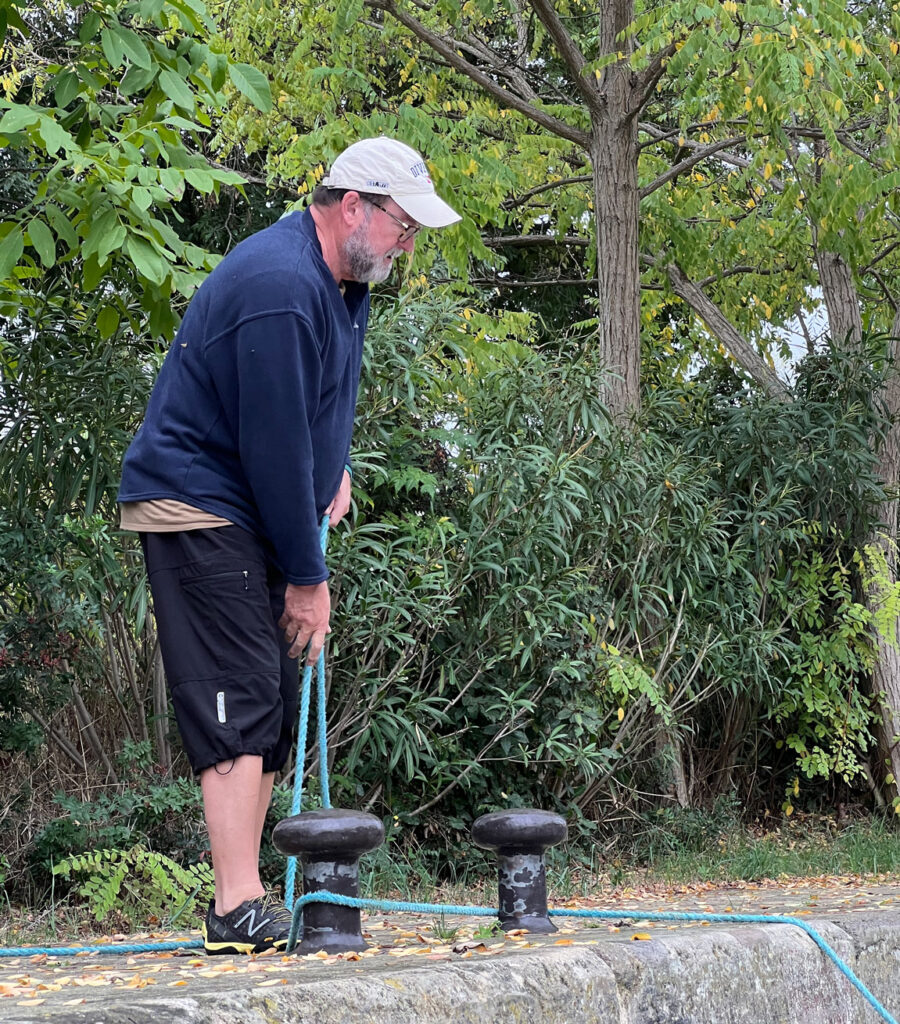
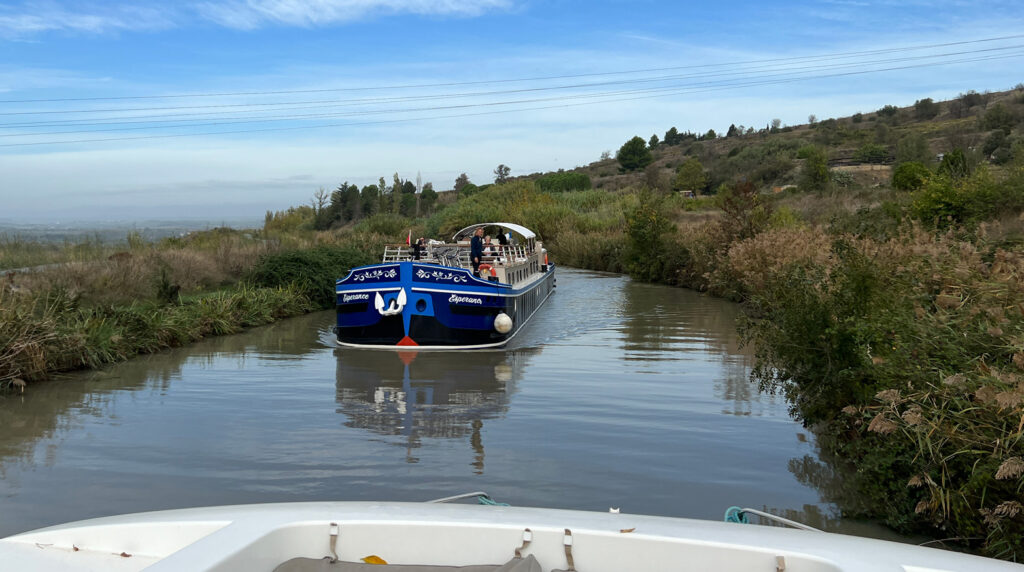
Meanwhile, I was at the helm, located forward and to starboard (right side) on the upper deck. This birds-eye-view of the bow of the boat and the canal proved useful negotiating the narrow lock gates. Inside the lock, my job was to stabilize the boat in the churning water as the lock flooded. The turbulence was such that I had to work the bow thruster, engine and rudder—sometimes sequentially, sometimes simultaneously–to help keep the boat off the wall and away from other boats in the lock with us.
Rules of the Road
Speed limits on the canal range from 3 to 8 kilometers/hour with no-wake zones in ports and marinas and anywhere boats were tied to shore. We also slowed when approaching locks, bridges, other boats and the aqueducts and tunnel on the route.. We had 7 days to travel 80 kilometers (50 miles) and get through 18 locks. Total engine run time was expected to be about 18 hours.
Schedule = No Schedule
Our typical day got underway by 9 a.m. It usually included four or five hours of motoring to the next destination. The rest of the day was devoted to relaxing, meal prep and consumption, dealing with locks and onshore exploration. We tied to bollards several times so we could lunch ashore, shop for provisions, explore ancient villages or visit nearby wineries. We rented bicycles for the week and biked a couple of times.
While underway, we were all usually on the upper deck. The upper deck featured bench seating and a table for dining as well as a gas grill, ice chest and collapsible rear bimini. The upper deck afforded a grand view of the canal and the countryside beyond both banks. As mentioned, the helm was forward and to starboard on the upper deck, to facilitate steering. Nearly all bridge openings were narrow, with room for one boat, so the high vantage point was helpful. Many of the bridges were low enough to require anyone on the upper deck to duck down. In some cases, overhead clearance above the railing was barely two feet! We had been instructed in Port Cassafières to put the canvas canopy down while underway to avoid its destruction or loss.
Béziers
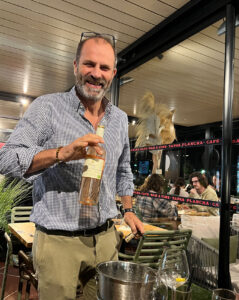
Midafternoon we tied into a slip at the municipal marina in Béziers, one of the oldest cities in France. Béziers has been inhabited since the late Stone Age (at least 2200 B.C.) and successively occupied by Greeks, Gauls, Visigoths, Romans and Franks.
Béziers gets its name from the colony established there by Julius Caesar in 75 B.C. With a current population of 75,000 people, it is the largest city on the stretch of the canal we would cruise. We originally planned to overnight in Béziers. The decision was rendered moot when we learned the éclusiers at the upcoming Fonserannes “stair-step” locks called for a strike the next day—thereby shutting down the locks. So we spent two nights in Beziers.
Our first night, we had an entertaining and delicious dinner at a Spanish restaurant in a nearby mall that night.
The Cathars
Despite Béziers’ ancient history, the oldest structures in use date only to the 13th century. An ancient walled city, Béziers was sacked and razed in 1209 in the Massacre de Béziers. Most of the 20,000 inhabitants were murdered. It was the kickoff of a Catholic crusade to quash an upstart religious movement called Catharism; Béziers was a Cathar bastion. The Catholic pope, Innocent III, enlisted the king of France and his nobles to extinguish the heretics and protect Christiandom. In addition, the French crusaders appropriated lands in Provence, Languedoc and adjacent feudal states. The crusade lasted 20 years, resulted in over a million deaths and effectively created modern France. The crusade then segued into the Inquisition, which sought to root out remaining Catharists and other non-Christians and their beliefs throughout Europe. The Inquisition continued until Napoleon Bonaparte abolished it in the 1800s.
Centre de Ville
The next day we hiked uphill to the old centre de ville to bask in its medieval-ness and find the locally famous enclosed food market. The hike up from the port includes getting around the busy Gare de Béziers railway station before entering the large hillside park rather awkwardly named Jardin du Plateau des Poetes (“garden of the plateau of the poets.”)
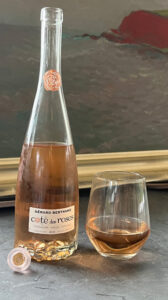
We ascended grand concrete, navigating around fountains and fishponds with swans. Statues of famous French writers are scattered among trees, flowerbeds and lush green grass on the steep slope. The park gives way to Les Allees Paul Riquet, a wide boulevard anchored by a grand 19th century theater. Named for the designer/builder of the Canal du Midi, this grand promenade includes a statue of Béziers’ favorite son looking down the mall toward the canal he was instrumental in building. The tree-filled boulevard is lined with restaurants and bars and divides the oldest part of the city from newer neighborhoods. We walked along the promenade—most of which was under construction.
The Market
Then we entered the warren of narrow streets and alleys of the old centre de ville in search of the enclosed market. The 13th century was still the Middle Ages, so the old city was originally designed for foot traffic and animal-drawn carts. At the market we bought herbs, olives, assorted breads and cheeses as well as prepared dishes to heat up on the boat. We also picked up some wine and spirits at a nearby wine shop where Gene and Kathleen scored a favorite bottle of rosé that happened to be from Languedoc. Cote des Roses became our go-to wine for cheese boards and light meals. We’re also finding and buying it here in California, where we are spending most of this winter.

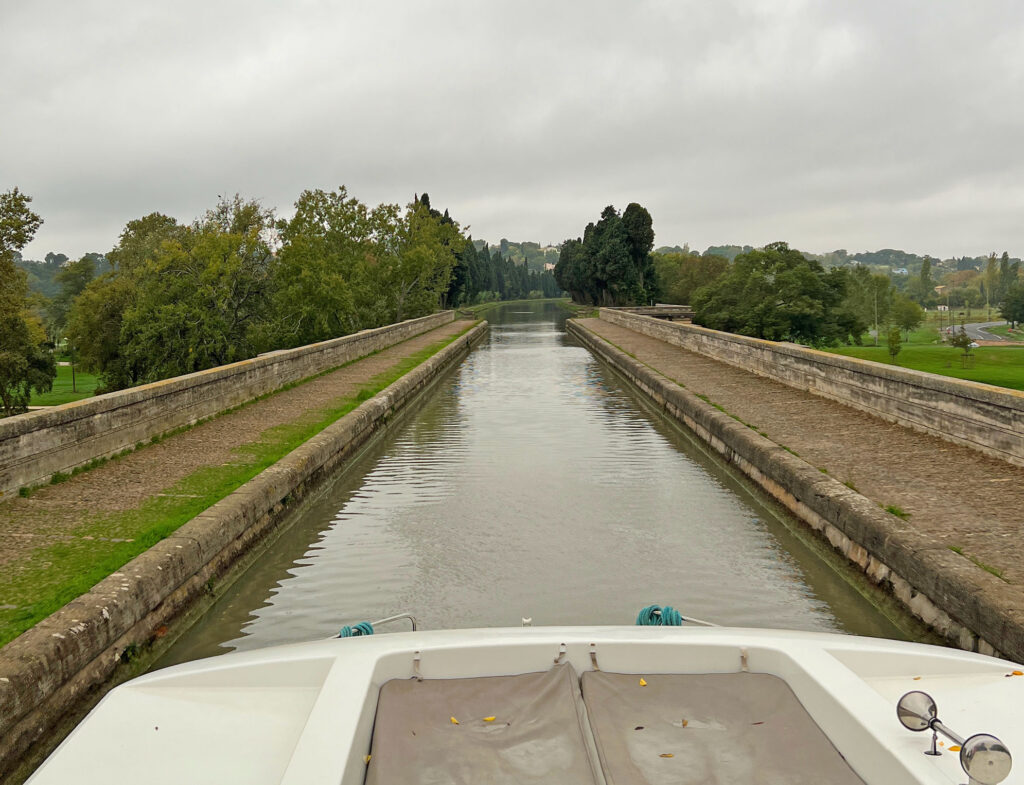
Aquaduct
The next day we set off and immediately navigated the Beziers and the Orb locks, before crossing the water bridge—or aqueduct–over the Orb River. This was our second aqueduct, the first being the Canal Latéral à la Loire over the Loire River at Briare on our 1998 canal trip. The 787-foot Orb Aqueduct was the first aqueduct built in France.
Écluse de Fonserannes
Next up was the famous écluse de Fonserannes: the staircase locks. The Fonserannes consists of six sequential locks, with each oval-shaped lock ranging from a couple feet to as much as 12 feet above the previous lock making for a stairstep effect. Two éclusieres were on hand to run the locks. The locks operate in one direction at a time: locking up in the morning, locking down in the afternoon. We entered the first lock at noon, behind another chartered boat about the same size as ours. The sailboat from the previous day left earlier in the morning, well ahead of us.
Chaos in the Locks
It became clear in the first lock that the other boat’s crew of two were inexperienced boaters. They could barely control their boat in the turbulent rising water with the man ashore handling docklines and the woman at the helm. In the third lock, the man began chatting up a jeune fille on the shore and his crew mate left the helm to take pictures! I had to back our boat and steer away several times to avoid getting smacked by the stern of the uncontrolled boat. The éclusiers finally noticed the other crew’s difficulties and slowed the incoming water in the next locks to quell the turbulence.
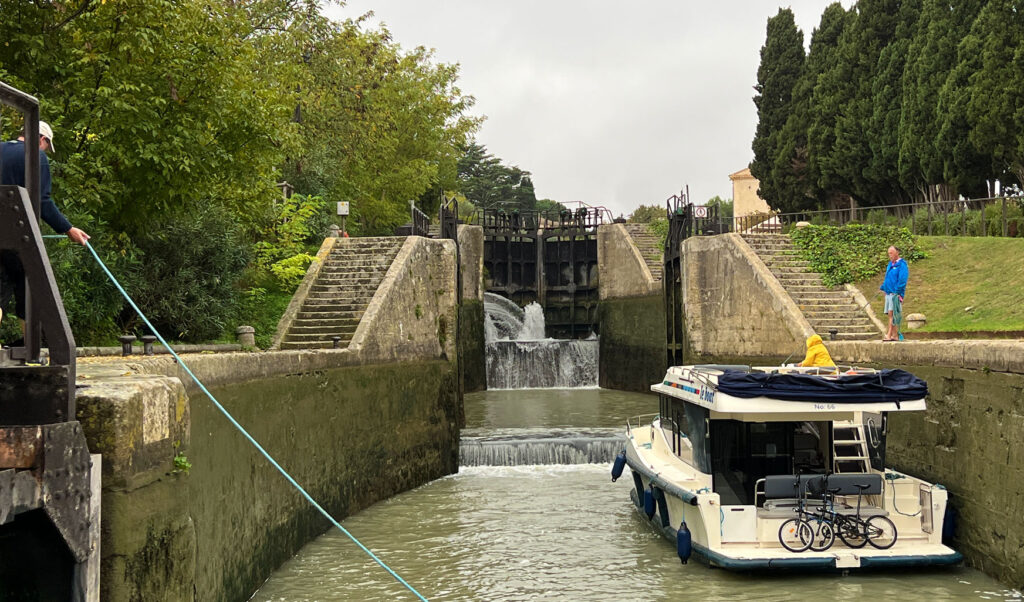
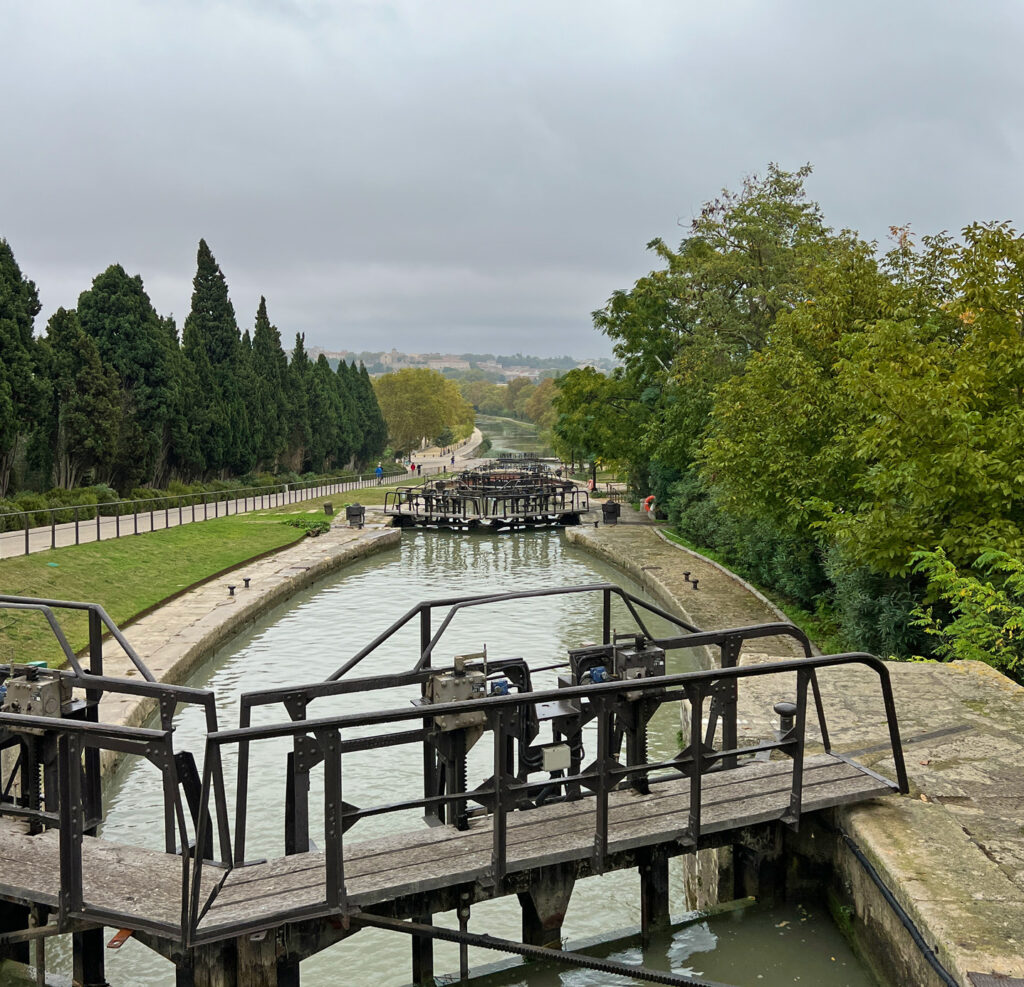
We were through the locks in less than an hour, photographed all the way by gawking tourists lined up along the lock banks. On leaving the uppermost lock we made a quick stop at the gift shop and restaurant to peruse the array of souvenirs and Fonserranes printwear. We escaped with a commemorative magnet and coffee mug. (The coffee mug did not survive the trip home; presumably Julie will buy a replacement on a future visit.)
The Tunnel
To our delight we soon found ourselves approaching the Malpas Tunnel under the hill d’Enserune, just 12.6 km from the stair-step locks. The 541-foot tunnel was secretly excavated in 1679 after the French prime minister stopped work due to the unstable soil structure of the hill. Critics of the canal project expected the impasse to doom its completion because alternatives to a tunnel were deemed untenable. Riquet gambled that it was better to ask forgiveness than seek permission.
Before the king’s experts could arrive to assess the situation, Riquet’s crew worked round the clock to dig the tunnel and seal it with concrete to prevent collapse. The concrete support worked and the project continued to completion a couple of years later—but without Riquet. While he obtained the forgiveness for digging the tunnel without permission, his health failed and he died before the canal was completed. His sons took over the project and the canal opened for business in 1682.
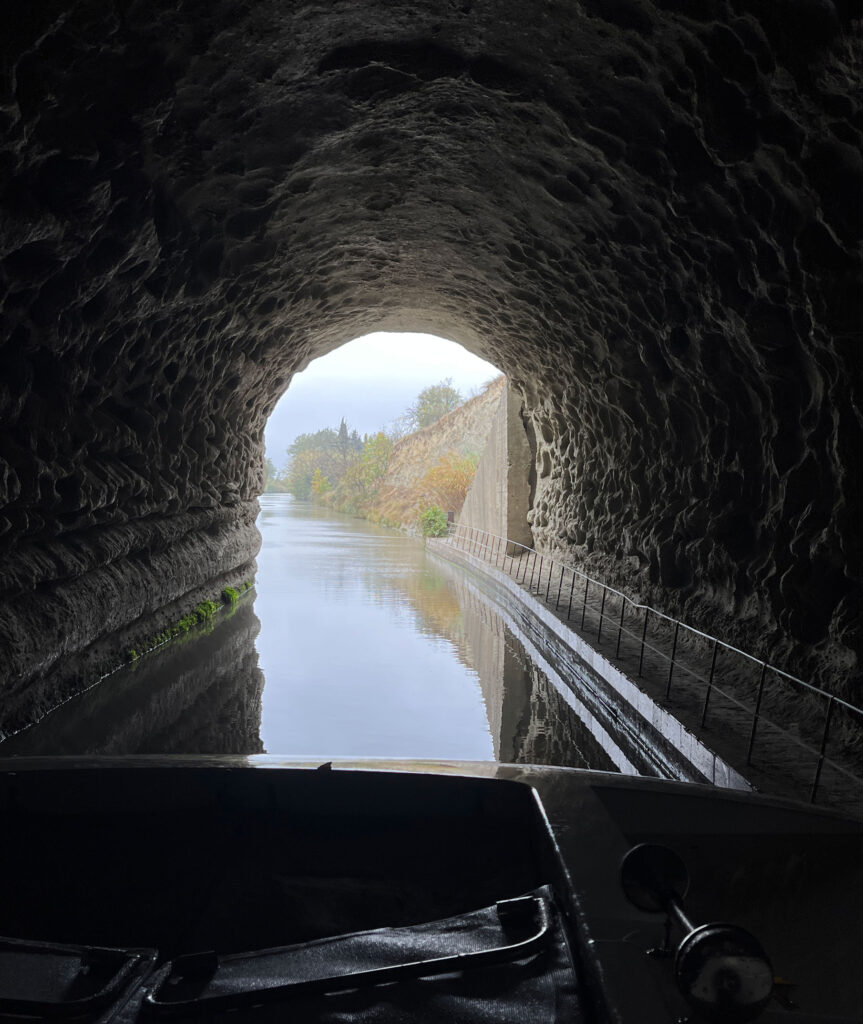
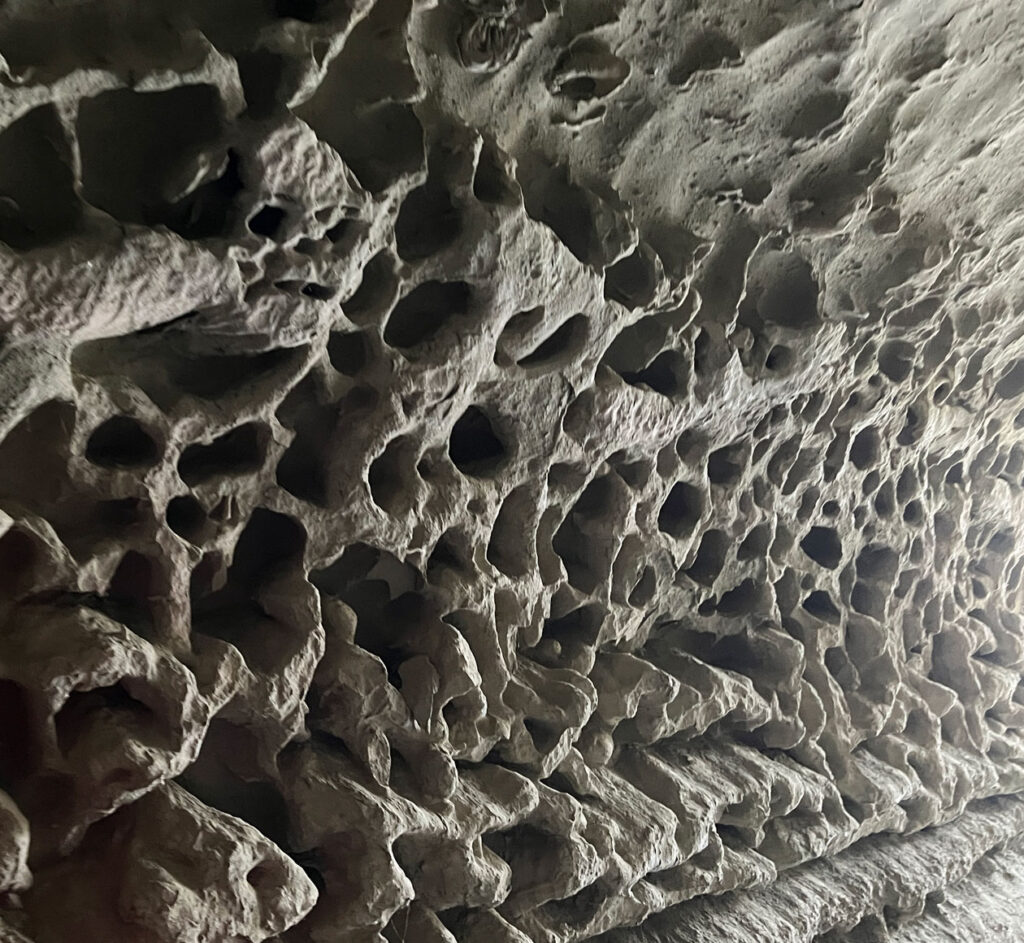
The Wine Inn
In our excitement over transiting the Malpas Tunnel we missed a couple of nearby attractions, including the Oppidum of Enserune, which has remnants of an ancient fortified Greek settlement. We continued on to the village of Poilhes, where we tied up on the wall as the sun was setting. As it happens, we were just a few hundred feet from the Vinauberge, literally “wine inn,” a wine bar/restaurant/inn occupying an old winemaker’s cooperative. It now caters to professional vignerons (grape growers/wine makers) and tourists alike.
We had already eaten dinner on the boat when we crossed the street and entered the wine bar, so we did not order dinner. We learned later that the food was highly regarded. The weather was turning cold and blustery and threatening to rain, so the warm, inviting wine bar was greatly appreciated. While we didn’t eat, we did sample most of the wines, which were served from pressurized dispensers along the wall. Prepaid electronic charge cards obtained from the bartender activated the self-service devices. It was all very novel and fun and we were able to sample an array of fine wines produced locally.

Wineries and Ancient Villages
The next day we lunched canalside in Capestang and were entertained by boaters parking their rent boat in a slip across the canal, next to a bridge. The episode included several minutes of out-of-control maneuvering as a crowd gathered on both sides of the canal and the nearby bridge. Even the chef from our café emerged from his kitchen to watch and soon joined the chorus of encouragement, advice and jibes from the crowd.
The boaters finally tied up to shore and earned an insincere ovation from the bystanders. The French can be snarky. It should be noted that the canal has no current, so the boaters’ difficulties was of their own making. Thankfully, they were heading downstream, so we didn’t have to deal with them in any locks.
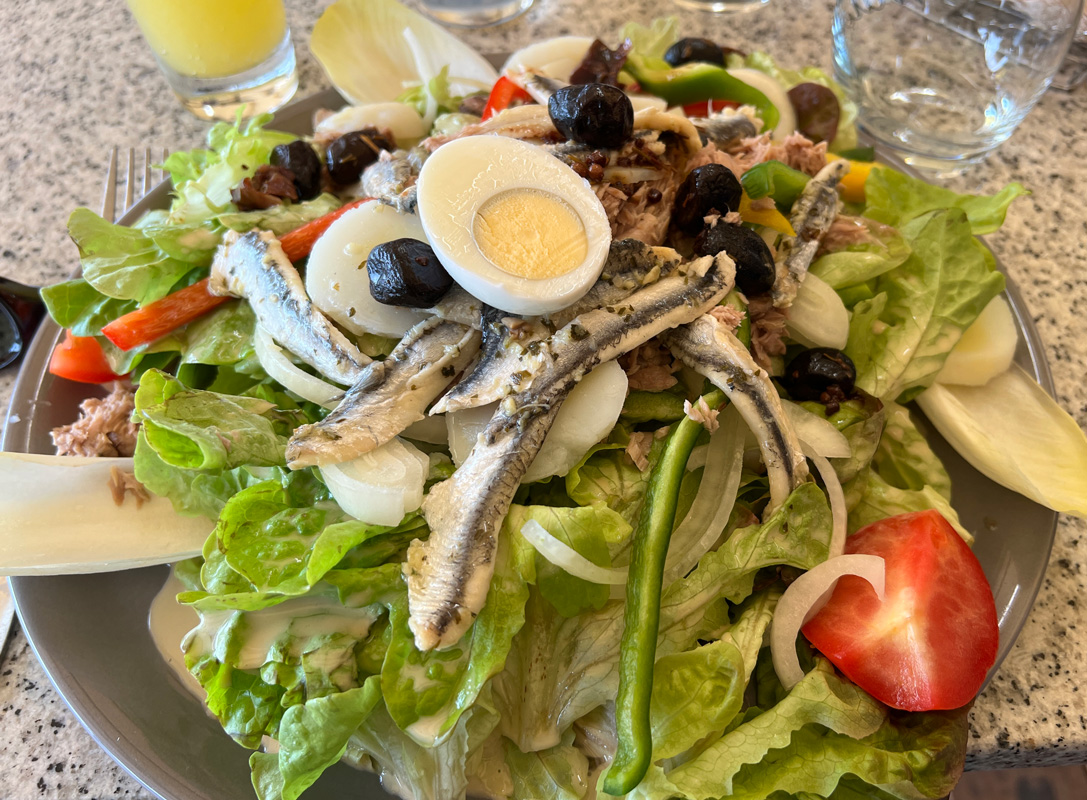
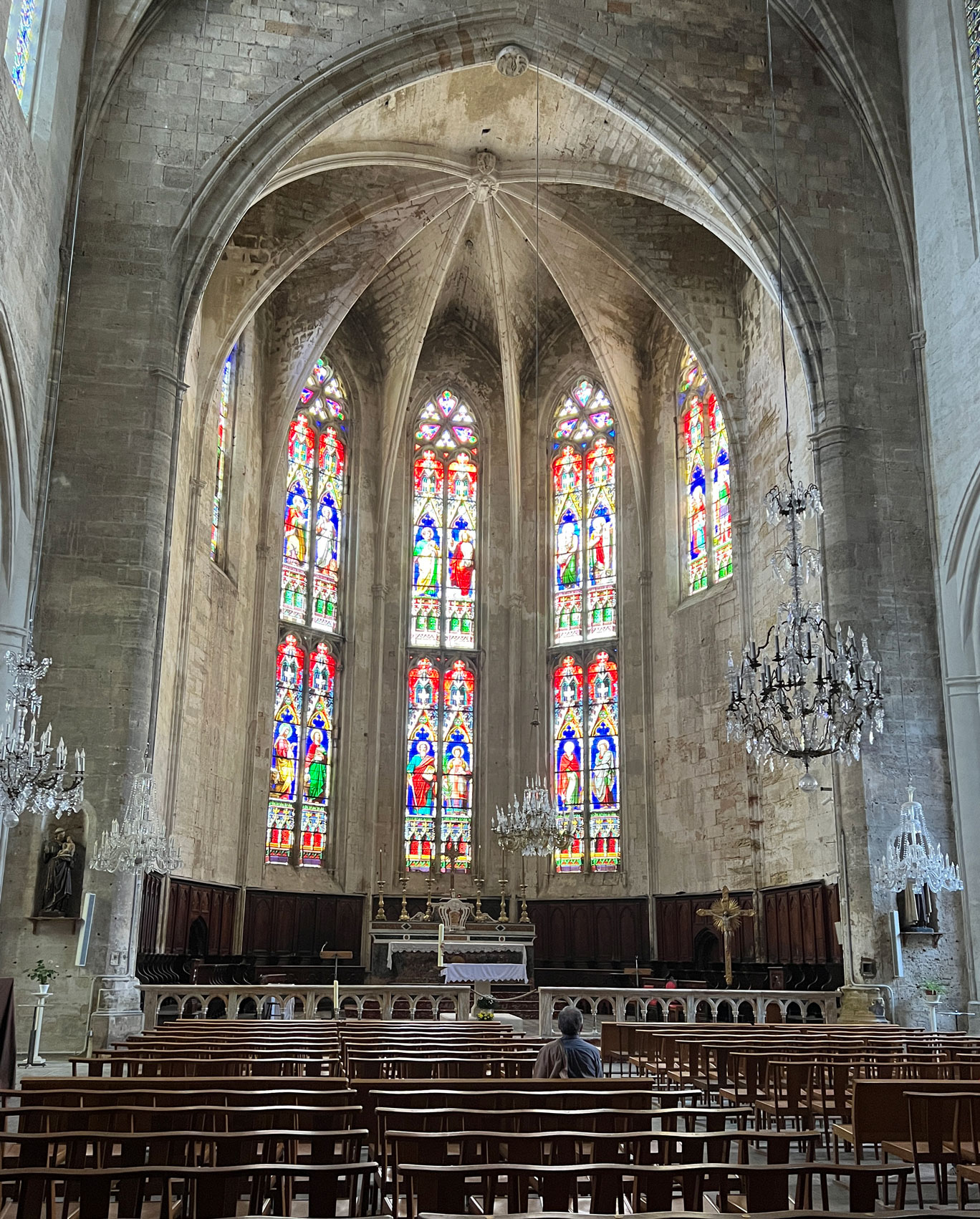
After lunch we did a walking tour of the ancient village, taking in a small square featuring a fountain with some great trompe l’oeil wall art and visiting the gothic St. Etienne cathedral.
Poilhes
As we ventured up the canal over the next several days we enjoyed beautiful fall weather with clear, sunny skies and temperatures ranging from the low 40s Fahrenheit mornings to afternoon highs in the 60s F. Outside of Poilhes we opted to spend the night. Delighting in the peace and quiet of the Languedoc countryside, we tied ashore next to vineyards and verdant pastures grazed by cattle, sheep, goats or horses.
We toured small villages by day, searching for fresh French bread and pastries, local wines and good cafés for lunch. Our last afternoon before arriving at Homps, our destination, we visited the wine chateau and museum in Ventenac-en-Minervois. There we tasted and bought more excellent wines, toured the museum of wine production on the top floor and climbed the round tower on a corner of the building.

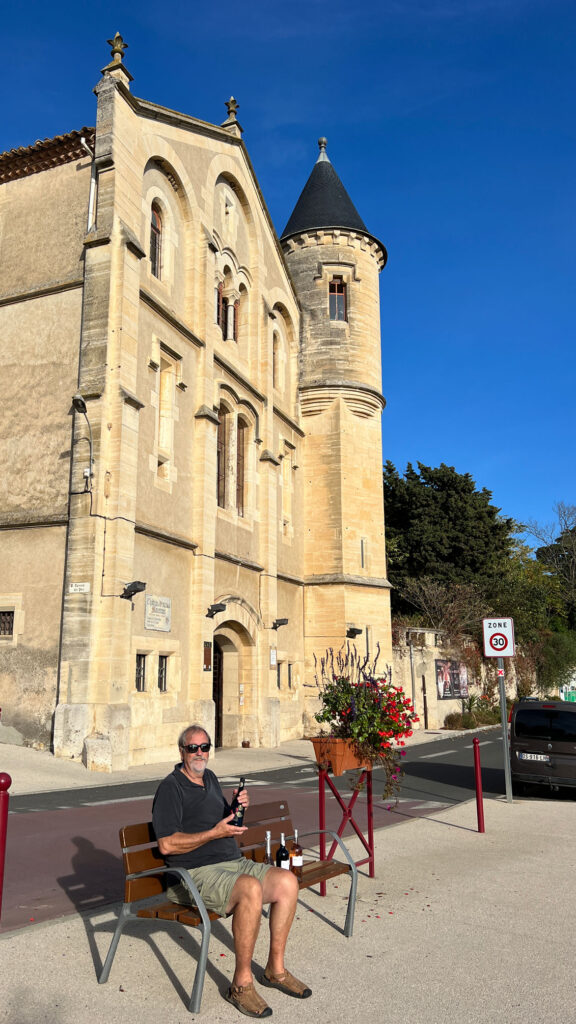
That night we tied ashore in a stretch of the canal overarched by the famous “barkless” Plane Trees. Plane Trees were planted along many stretches of the canal in the 1830s to shade the canal, help cut wind and reinforce the canal’s banks. They proved susceptible to a fungus that arrived during World War II with wooden U.S. military ammunition boxes. The iconic Planes are being cut down and replaced with assorted other fungus-resistant trees. Long stretches of the canal we cruised were dotted with Plane Tree stumps interspaced with saplings. We felt privileged to spend our last night out under the embrace of these stately, but doomed trees.
End of the Canal Trip
On our arrival in Homps we were dismayed to discover that that there was no pump out available for the blackwater holding tank on our boat. We knew that nobody swam in the murky canal and had noticed the lack of waterfowl and fishermen along the banks, but we were aghast to learn that we were expected to periodically pump our holding tank directly into the canal! That was an instruction we missed during our orientation session at Port Cassafières a week earlier. We had been on the lookout for pumpouts at marinas along the way and anxiously monitored the holding tank gauges as the week wore on.
Fortunately, we didn’t overfill the nasty tank and left it to the Le Boat crew to empty after we departed. On reflection, we were surprised the slow-moving water in the canal was not redolent with human waste and cluttered with dead fish. Discovering this lack of waste control was a singular shock and the biggest negative aspect of cruising French canals.
For our last night on the canal we dined at a nearby restaurant. It was our second night dining out during the entire cruise and we thoroughly enjoyed ourselves. We strolled to the restaurant earlier in the evening but stumbled back to our boat. Some of our crew remember the evening better than others, but we all agreed the cruise on the Canal du Midi was a memorable adventure.

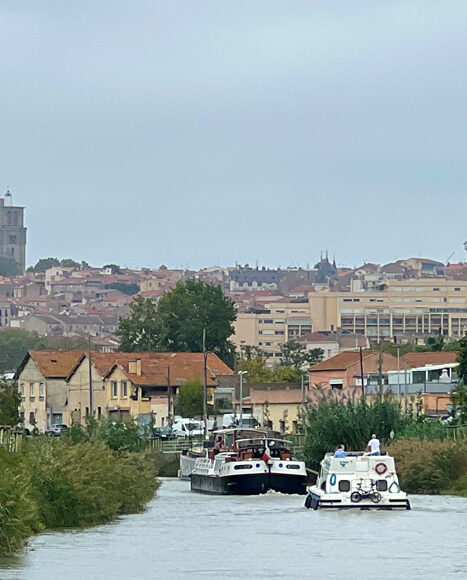
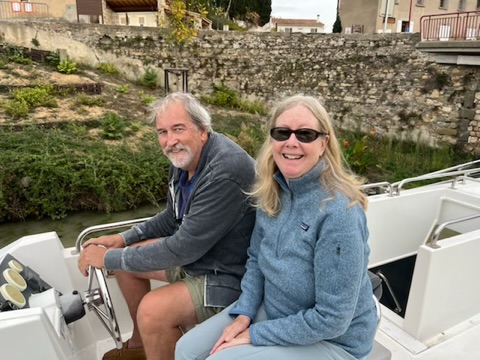
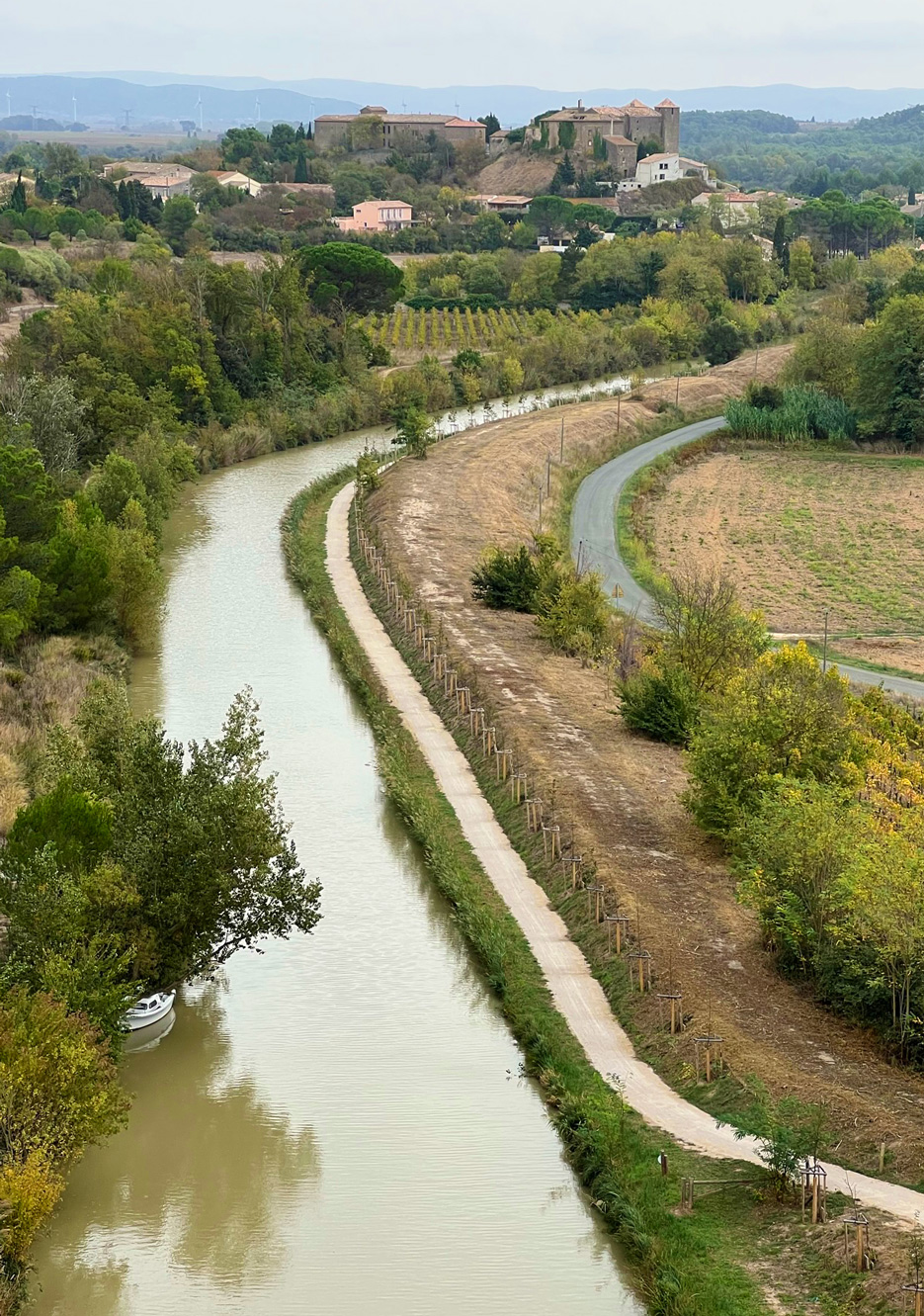
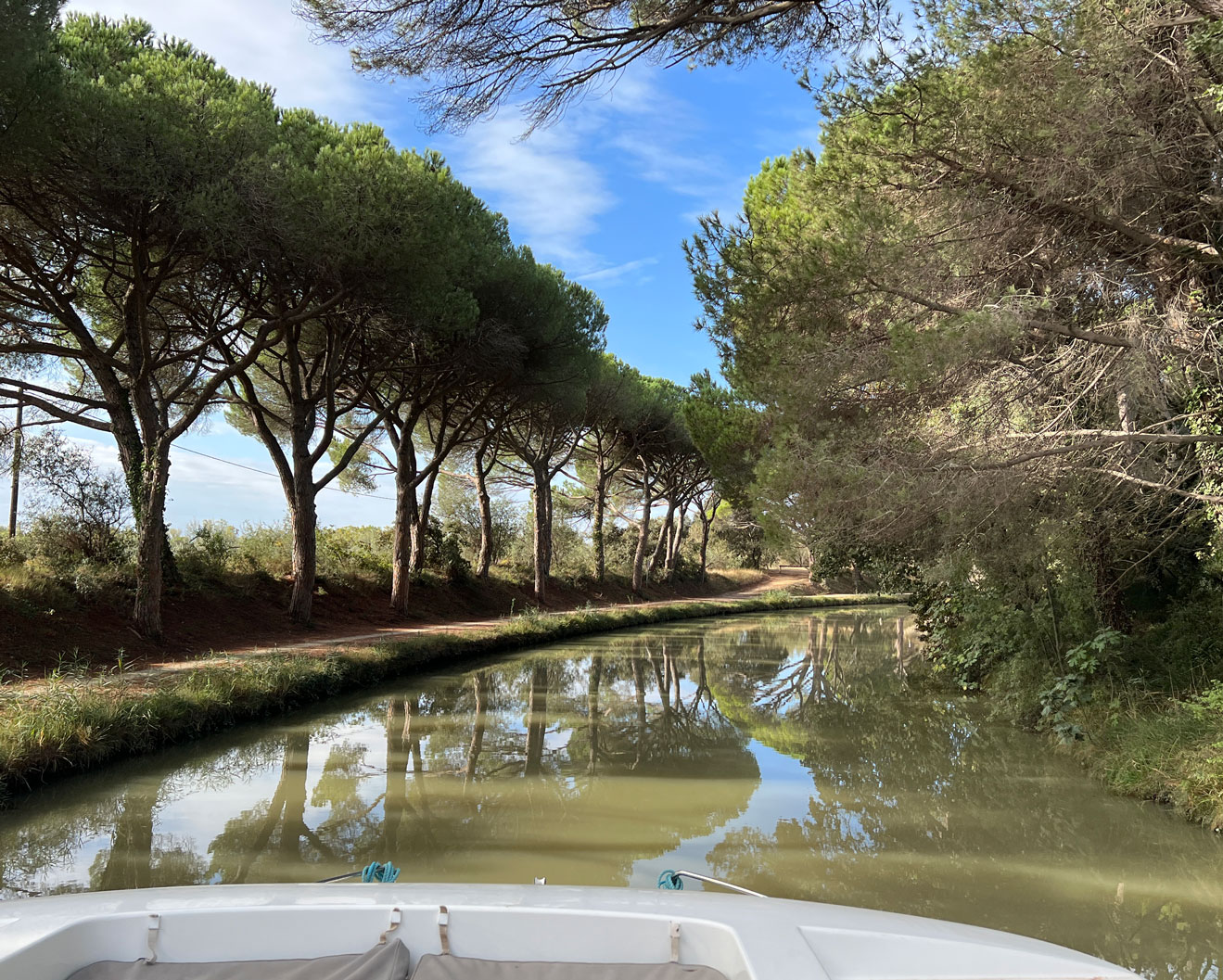
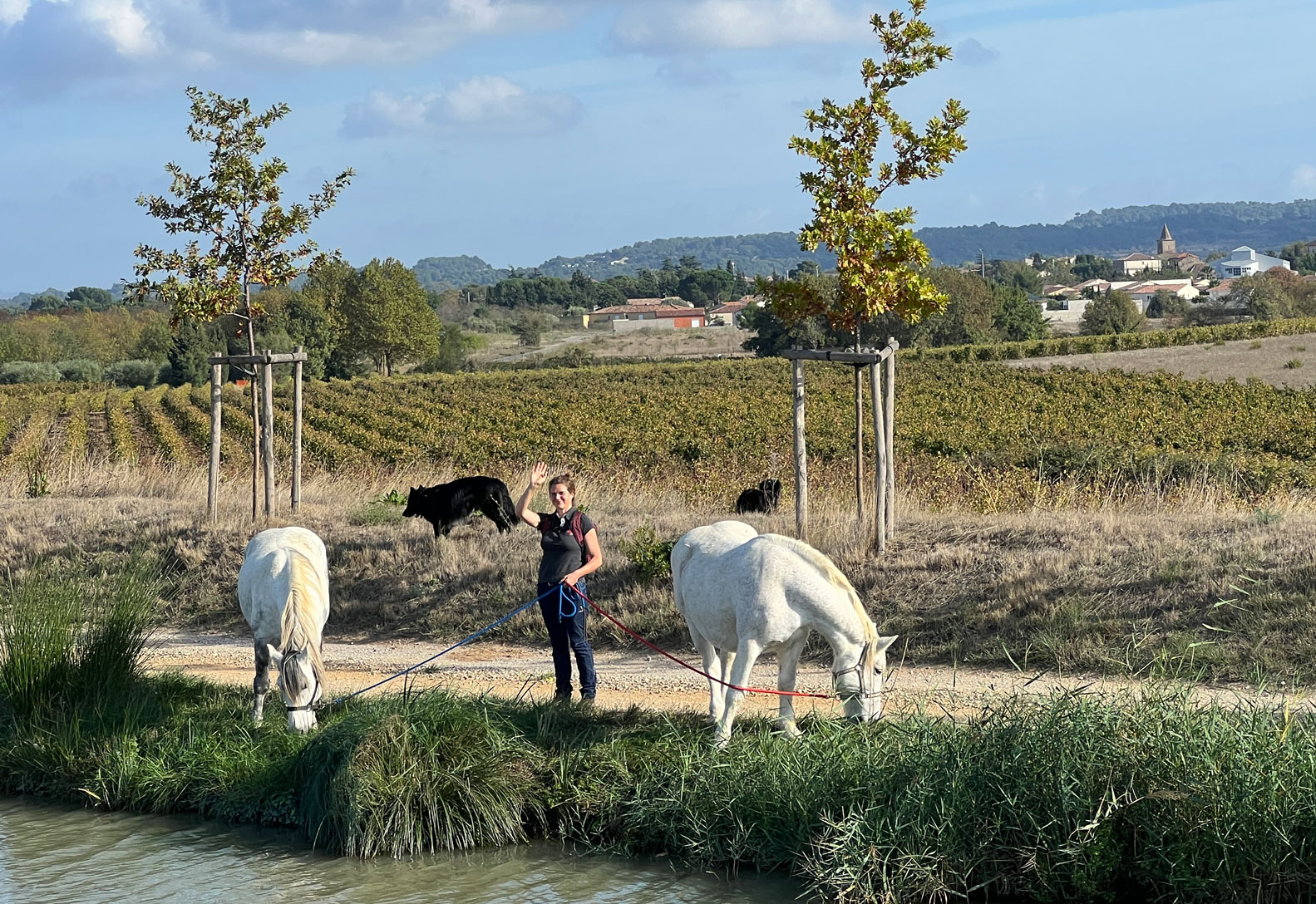
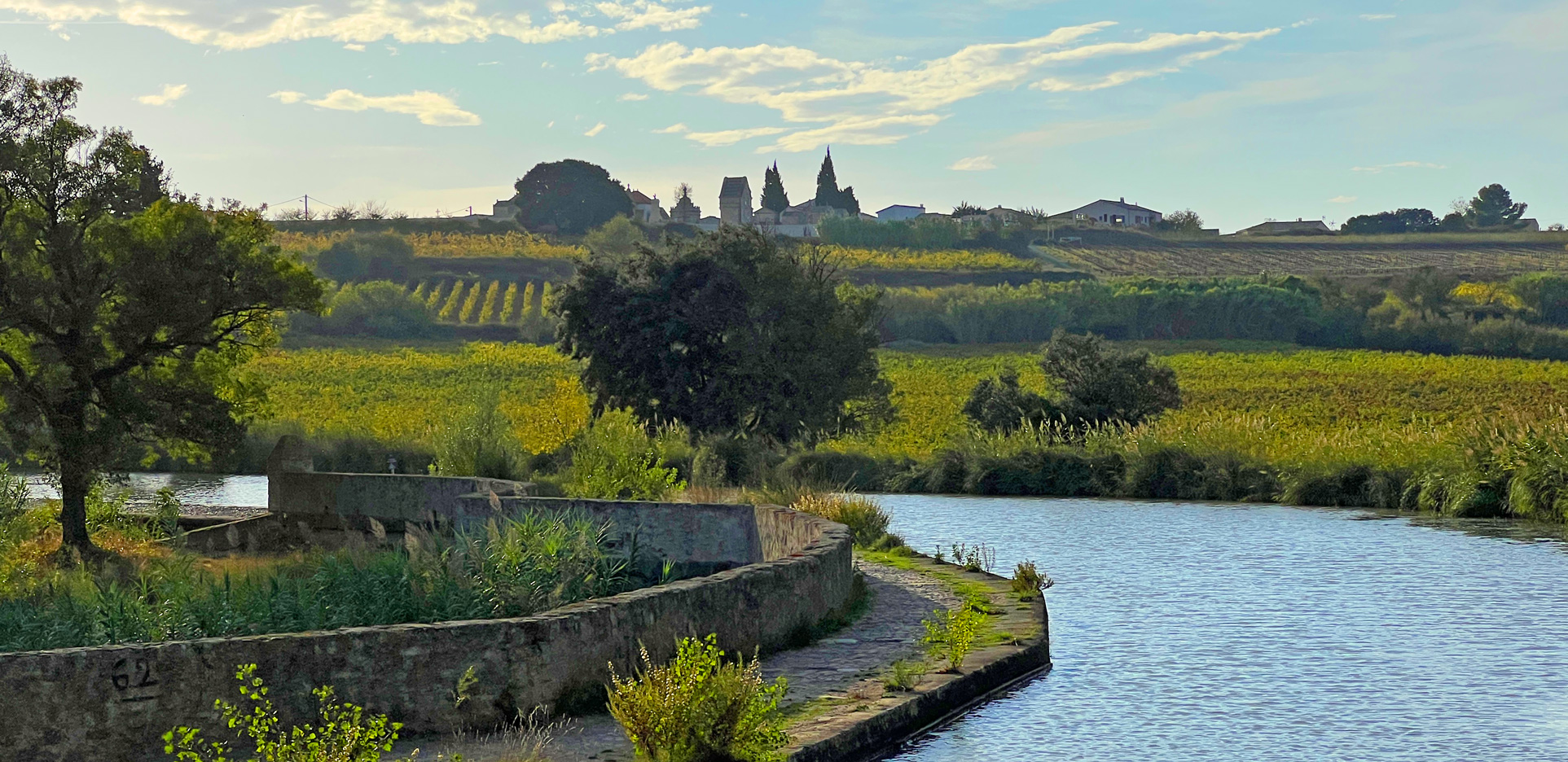
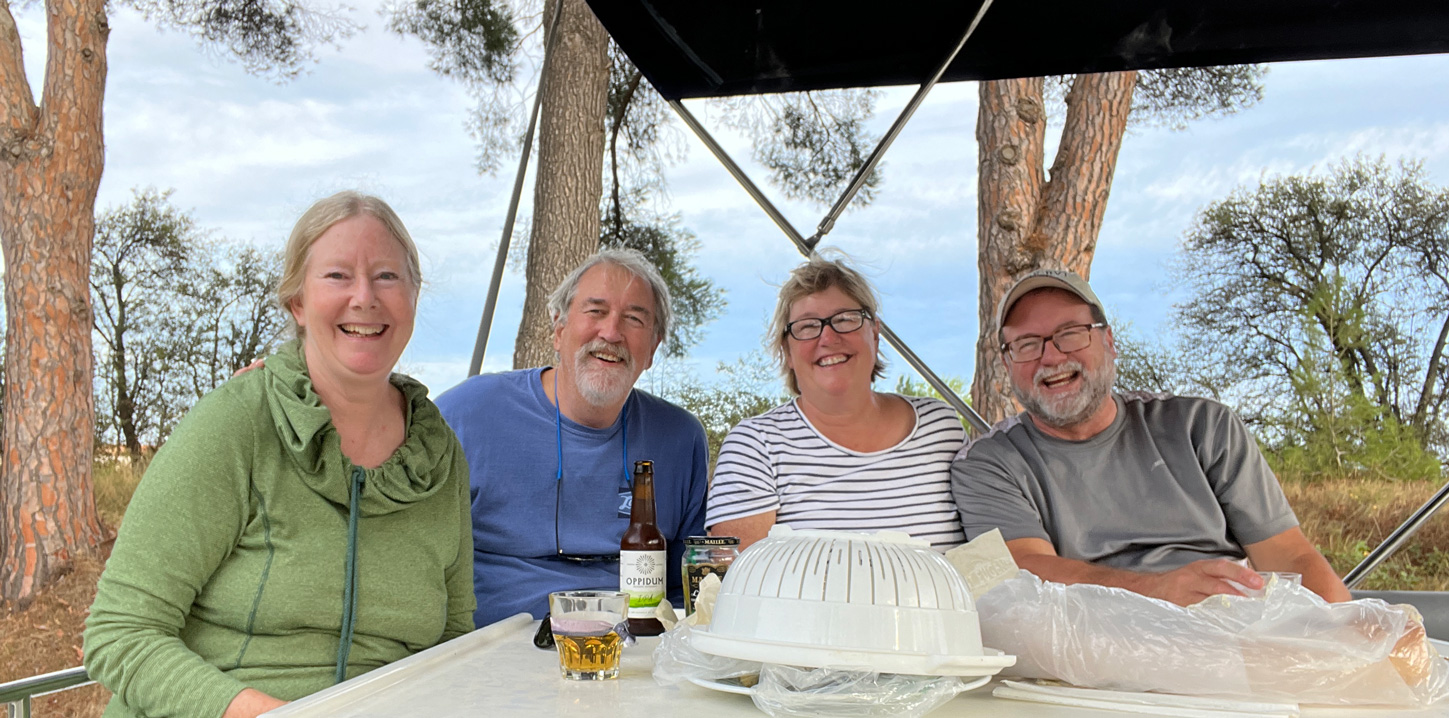
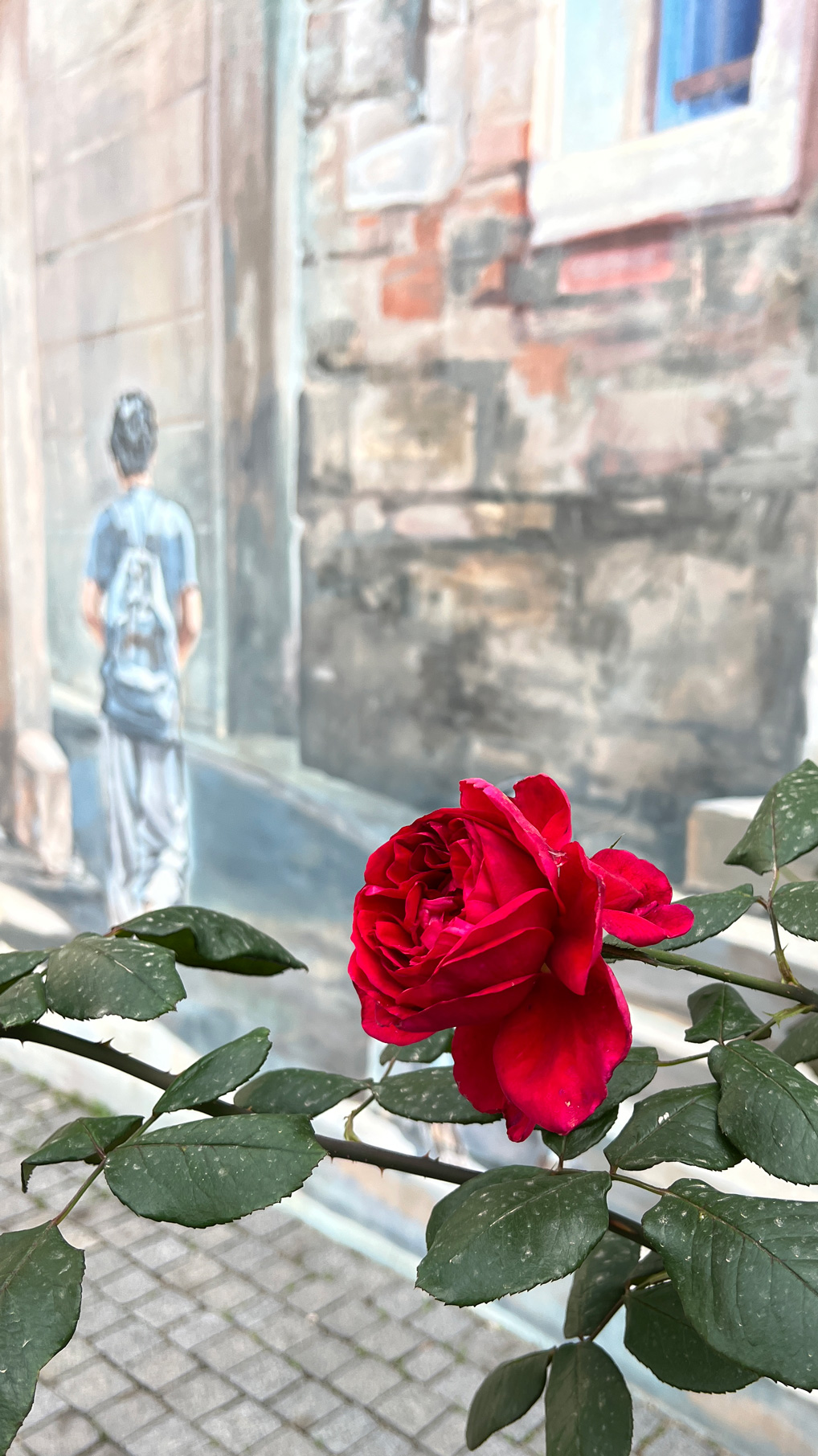
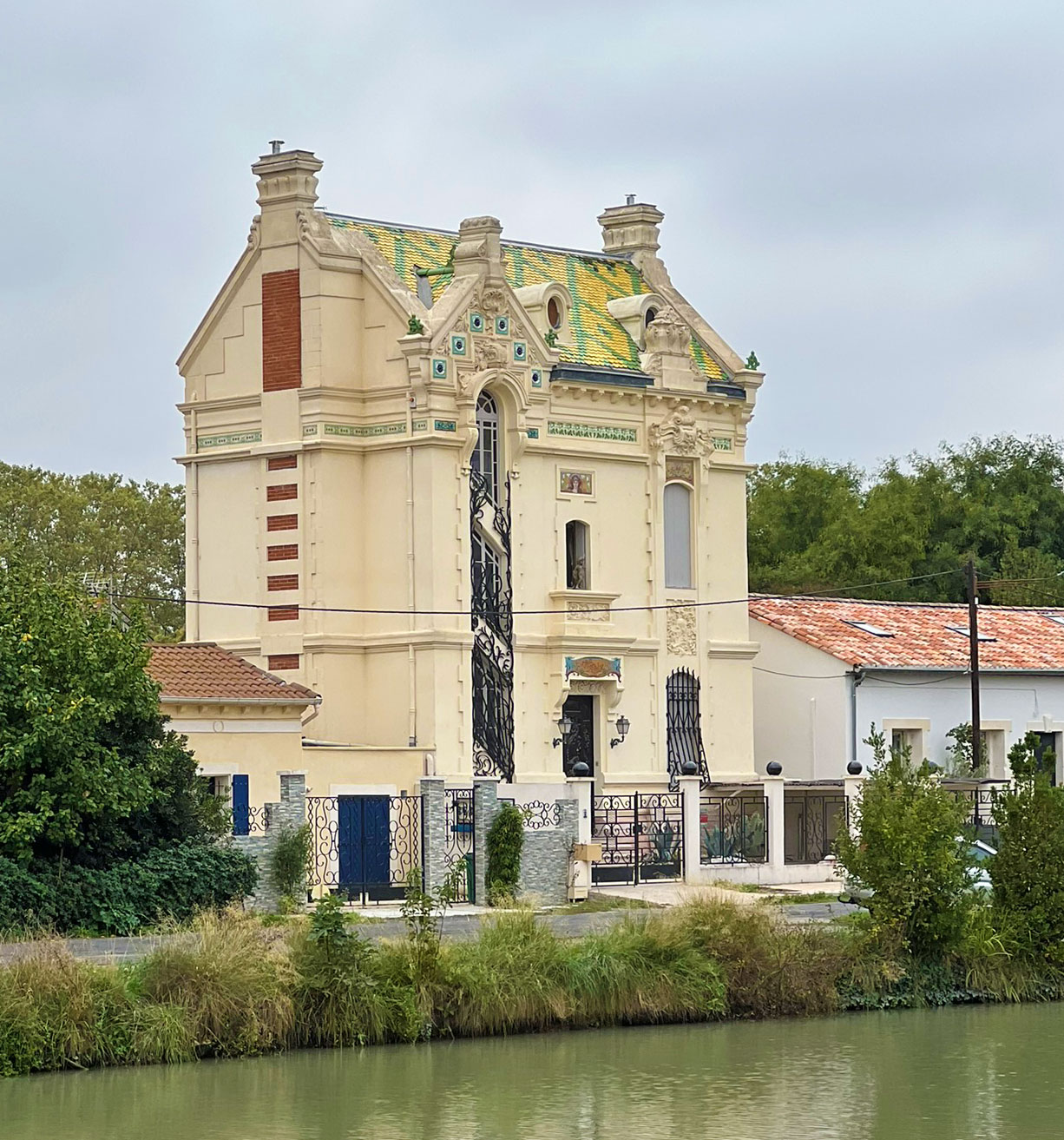
Great story, Dan.
Best wishes from Bruce & Concha